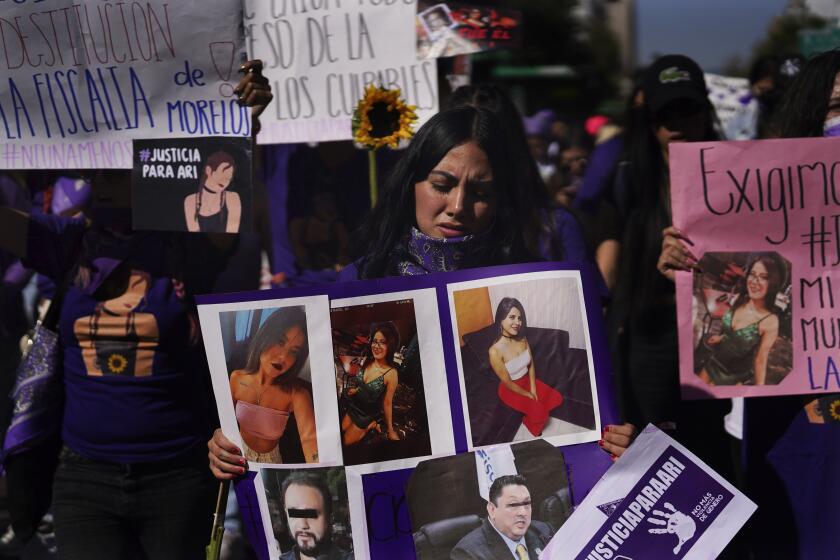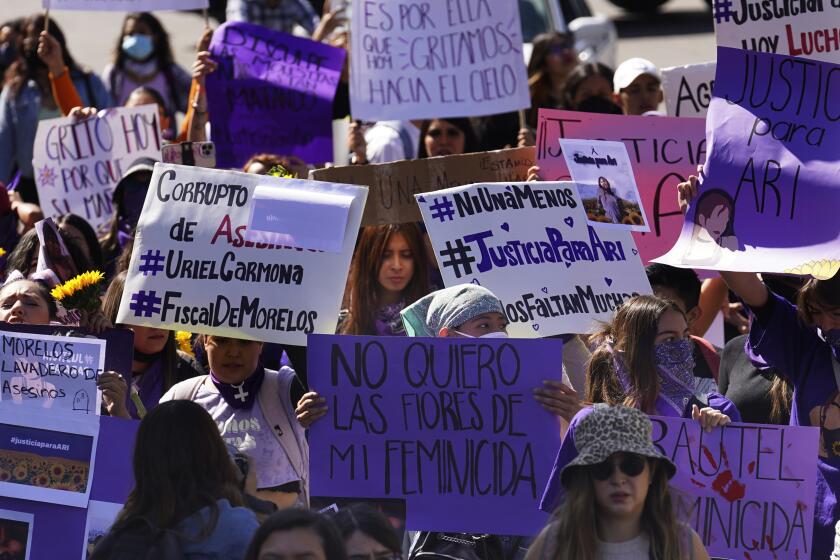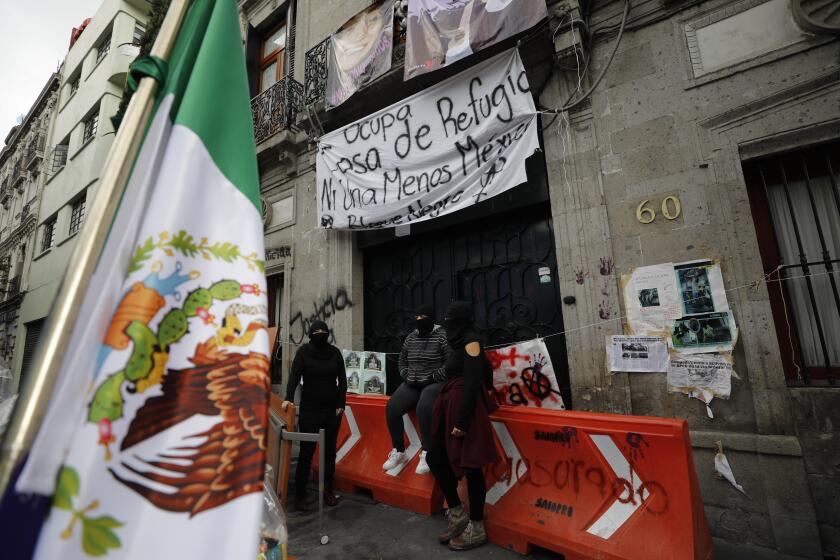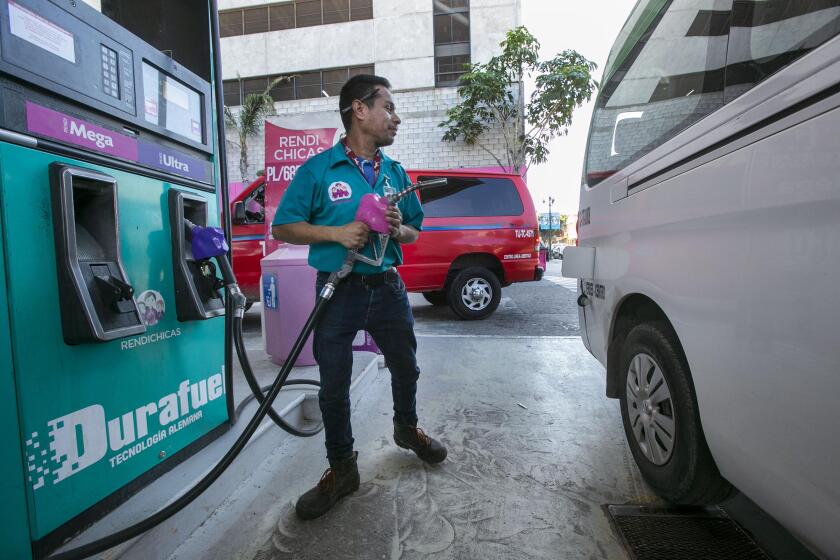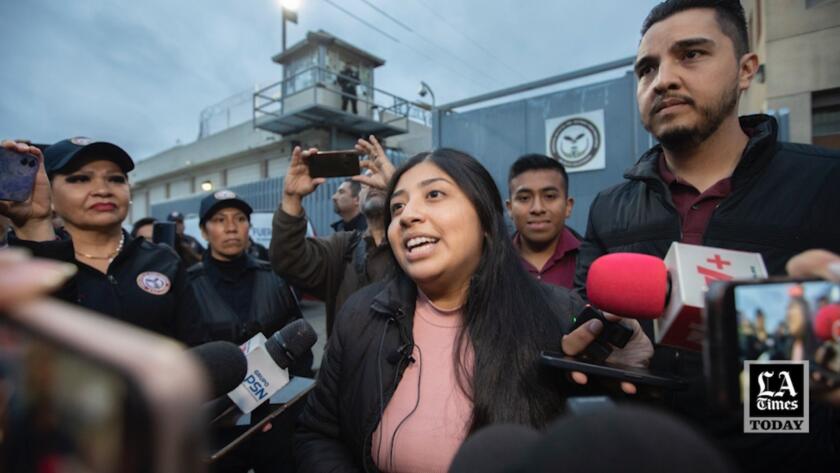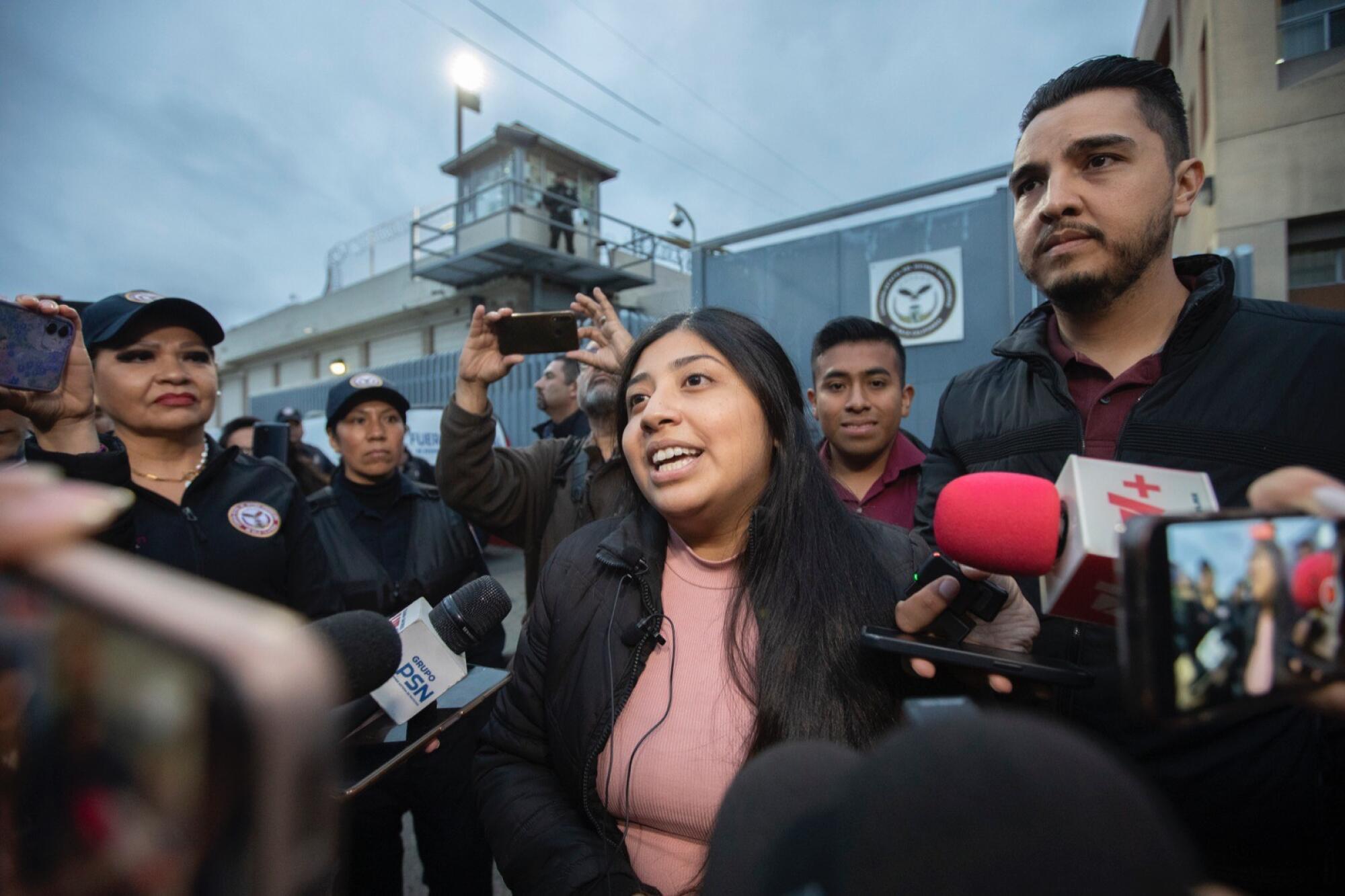
TIJUANA — Alina Narziso had grown used to putting on makeup and sunglasses to hide her bruises.
They came from her boyfriend, an officer on the Tijuana police force with Narziso. He tightly monitored her whereabouts and would slap her and squeeze her neck in fits of rage.
Narziso, then 24, recalled reporting the abuse to a boss, who sounded unconcerned.
“I don’t think he’s capable of killing you,” he told her.
The violence, in fact, did turn deadly. But it was Narziso, not her boyfriend, who was led away in handcuffs and charged with murder.
In a country where an average of 10 women were slain a day last year, sometimes by their romantic partners, Narziso’s case shows how Mexico deals with a lesser-known outcome: when a woman kills her alleged abuser.
Mexico’s criminal justice system has long shown little sympathy to abused women, activists say. Allegations of domestic violence are often pushed away and killings of women are poorly investigated. But a strong feminist movement has moved cases such as Narziso’s into the public eye, forcing judges and legislators to pay attention.
The Times reviewed court documents and spoke with legal experts, activists and family members in reporting this story. The events are as Narziso described them in several interviews and in court testimony.
Narziso joined the Tijuana police at age 19 at the suggestion of an uncle on the force. Before that, she’d worked as a hairdresser.
She thrived patrolling the busy streets, feeling like she’d found her calling. Shopkeepers took her personal number and contacted her with suspicions.
She’d been on the force about four years when, in January 2019, 27-year-old supervisor Luis Rodrigo Juárez moved to her police district. They soon became patrol partners.
Their long days on the job extended to a friendship, dancing and barbecues.
“We only wouldn’t see each other to sleep, but the rest of the time we were together,” Narziso said.
Two months after Juárez arrived, he brought her to his parents’ home. The pair fell asleep watching TV. The next morning, she said, she woke up with Juárez on top of her. He pinned her hands down and forced her to have sex, she would later testify in court.
Afterward, when she tried to leave, Juárez became remorseful.
‘I thought about leaving him, but I didn’t know how.’
— Alina Narziso
“He told me, ‘I’ve never spent so much time with a girlfriend, you’re the first person I’ve been with this much. I don’t know how to treat a woman,’” Narziso said. “He apologized and gave me a thousand explanations.”
It was the start of a pattern — abuse, then contrition. Narziso stayed with him, and the two began renting an apartment that summer, in the same building where she had lived with her mother.
One night in September, when she was bathing, Juárez accused her of cheating on him and grabbed her by the neck. When she denied it, he slapped her. Then he apologized, hitting his head with his hands, she said.
She texted photos of her face, and her location, to two colleagues in case they didn’t hear from her in the morning. But the next day, Narziso and Juárez both reported to work.
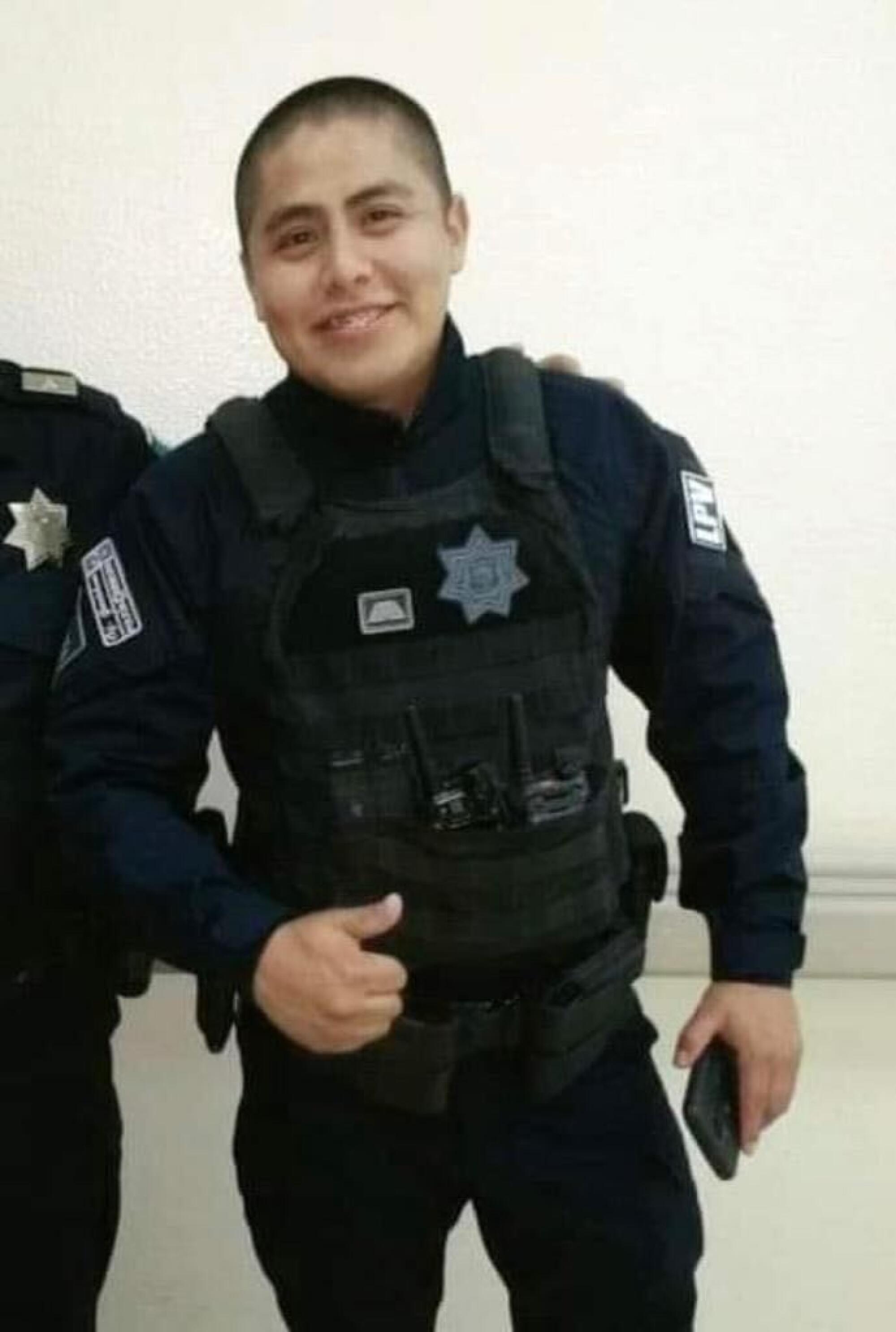
“I thought about leaving him, but I didn’t know how,” she said. “We were patrolling together.”
The violence continued. One day when Narziso tried to leave the apartment for a salon appointment, Juárez pushed her to the ground. He ultimately let her leave, but when she returned, he blew up, demanding to know why she had taken so long.
For Narziso, it was too much. When he left for work, she started packing to leave. Her mother, Socorro Tehuaxtle, came over to help. For the first time, Narziso told her that Juárez was responsible for the bruises she had asked about.
The gruesome killing of Ariadna López shocked Mexico, spurred protests in the capital and highlighted the nation’s epidemic of violence against women.
Narziso asked a colleague to send a police unit to prevent Juárez from entering the apartment while she packed. She moved back into her mother’s unit.
Over the next few days, Juárez would wait outside the apartment building with flowers. He approached her one day when she was eating at a restaurant, asking her to give him another chance. Again, she agreed, but set a condition: that he see a psychologist and stop drinking. They soon began living together again, but he refused to go to therapy, Narziso said.
“For me, this had already turned into a normal life routine,” she said. “I didn’t realize it was a vicious cycle, that nothing would change.”
She never filed a police complaint against him because she worried about retaliation within the force. She had already seen domestic violence reports get little attention.
Once, seeing her bruises, another officer had asked, “Now what did you do? Why did he hit you?”
On Dec. 12, 2019, around 2 a.m., Narziso said, she awoke to a wide-eyed Juárez on top of her.
“Are you going to leave me because I’m drunk and crazy again?” he said, grabbing her by the neck.
He pressed the barrel of his police pistol against her head.
Of course not, she told him, she wouldn’t leave.
He stowed the gun in his waistband and started to snort cocaine, she said, but as she tried to leave the bedroom, he grabbed her by the hair and started slamming her face against the door frame. “You’re not leaving here,” he told her.
As he put her in a chokehold, she screamed for help, hoping her mother, who lived on the same floor, would hear.
As they struggled, she pulled his gun from his waistband and pointed it at him, demanding he let her leave.
He stepped toward her. She closed her eyes and started shooting.
When she opened her eyes, he was slouched but still standing. He put his hand on his chest, she said.
“It’s your turn,” he taunted her. “Kill yourself.”
When he started to step forward, she shot again. And again. This time, she said, he fell to the floor. Relief and fear washed over her as he lay motionless.
Moments later she heard pounding at the door. Her mother.
Woken by Narziso’s screams, she’d heard gunshots while running for her daughter.
“What happened?” she asked.
“He was hitting me. I shot him, and I think I killed him.”
Her mother hugged the crying Narziso and told her to call 911. Narziso said that as she dialed, she felt confident authorities would understand her actions.
“I was sleeping, he assaulted me, I defended myself,” she explained later. “I was in that moment very sure of what I had done.”
The first authorities arrived at 2:33 a.m. Officials declared Juárez, who had been shot five times, dead at the scene. And they arrested Narziso.
A doctor who examined her a few hours after the shooting noted fresh bruises. But later that day, a Baja California prosecutor announced that she was uninjured and that no evidence supported that she had acted in self-defense.
At first, Socorro Tehuaxtle, 52, wasn’t sure how to help her daughter.
She began selling burritos and sweets outside the prison where Narziso was held to help her daughter pay for clothes. She gave Narziso’s car to an attorney to pay for her defense. She educated herself on Mexican and international law, took empowerment classes at a women’s center and eventually got a scholarship to go to law school.
Ariadna López was found murdered on the side of a road in Mexico, one of thousands of women murdered every year in the country. But her death outraged the country like never before.
She met journalists interested in telling Narziso’s side of the story. Gabriela Martínez, a reporter for the newspaper El Universal, thought of the mourning mothers she’d interviewed who wondered whether their daughters had tried to defend themselves.
“Many of us have been Alina in different phases of what she lived through,” Martínez said. “We always tell the story of a woman who has been killed. This was the first time that I was telling a story of someone who survived.”
When Narziso’s trial began in Tijuana in the fall of 2022, Martínez was there to cover it.
During the trial, an expert testified that Juárez had cocaine and a high level of alcohol in his system. The doctor who saw Narziso a few hours after the homicide said she had abrasions on her mouth and bruises on her neck and forearm.
Tehuaxtle testified that from her balcony, from which she could see the couple’s bedroom window, she had seen Juárez put Narziso in a chokehold. As she ran to their apartment in her slippers, she heard her daughter cry, “Let me leave!” and then the pop of gunshots. She feared her daughter had been killed.
In court, others backed up Narziso’s contention that Juárez had been abusing her for months.
A criminologist for the defense testified about his interviews with Narziso’s friends and colleagues, including one who said she’d seen bruises Narziso had blamed on Juárez. A colleague on the force testified that Narziso told him Juárez would point his gun at her in their apartment and that there were times when she was so bruised she couldn’t go to work. Narziso’s mother also testified about seeing marks on her daughter.
‘We always tell the story of a woman who has been killed. This was the first time that I was telling a story of someone who survived.’
— Gabriela Martínez, a reporter for the newspaper El Universal
A therapist whom Narziso saw three times in late 2019 said Narziso told her Juárez threatened her life, forced her to have sex, and told her, “Without me you’re nothing.”
Narziso also testified. She had not planned to kill her boyfriend, she told Judge Daniel Aguilar Patiño.
“I acted because there would have been no way for me to get out that day alive,” she said. “He was drugged, he was drunk, he had the weapon, and I know if I hadn’t reacted and taken it from him he would have killed me.”
But the judge said that there was no risk of Narziso being harmed and that she could have fired a warning shot or wounded Juárez instead of killing him. He ruled there was “not one objective fact” that showed she had lived under constant violence. He found her guilty.
In October 2022, he sentenced her to 45 years in prison.
In Mexico, a country known for its high rate of femicide — the killing of a woman because of her gender — a majority of females 15 or older have said they’ve been the victims of violence. Last year, 339,000 calls to 911 involved violence against women.
But authorities often brush aside women who report domestic abuse, activists say.
“We’re failing to recognize something: that violence against women in Mexico should be considered a national emergency,” said Patricia Olamendi, a former congresswoman in Mexico who is a legal expert on women’s rights. “We’re a country with strong machismo, prejudice and stereotypes about women — and that plays a role.”
Mexican rape victims and mothers of disappeared daughters seized control of a federal building last week.
Activists and attorneys defending women who’ve killed men in self-defense often point out that Mexico has long been a signatory to international treaties that require countries to protect women from discrimination and violence. Those treaties, legal experts say, underscore the obligation Mexican judges have, in cases where women kill in self-defense, to give consideration to what’s known in Mexico as “gender perspective.”
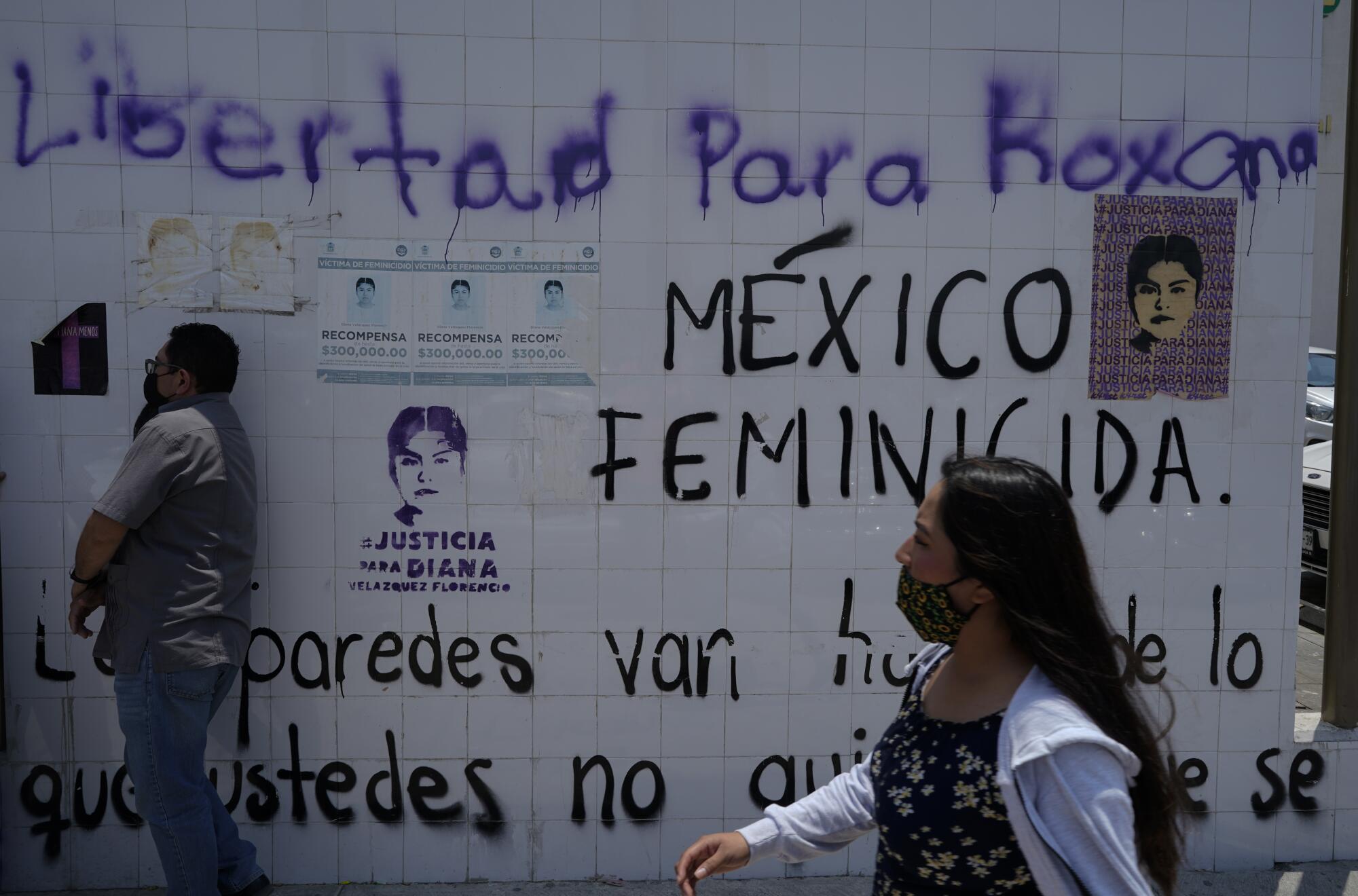
In other words, authorities should look beyond the specific moment of a killing and evaluate whether the woman who killed previously experienced violence that led her to believe her life was in danger. It also means taking into account physical differences.
“What happens if whenever your husband comes home drunk he hits you, so you live with this constant fear. Maybe that day he didn’t hit you or didn’t carry a gun, but faced with the fear that he was going to rape or hit you, you kill him,” said Daniela Ancira, the director of La Cana, an organization that provides legal services and job training to women in prison. “You need to take into account that many women experience years and years of violence.”
‘He was drugged, he was drunk, he had the weapon, and I know if I hadn’t reacted and taken it from him he would have killed me.’
— Alina Narziso
But activists have long accused authorities in Mexico of failing to do that. Moreover, Mexico’s standard for self-defense requires a real and “imminent aggression.”
Women who kill in self-defense are typically detained soon after, and prosecutors have only a short window to decide whether to seek pretrial detention, said José Antonio Caballero, a legal studies investigator at the National Autonomous University of Mexico. In homicides, he said, prosecutors may lean on the side of charging wrongly rather than freeing someone irresponsibly.
Some legislation has aimed to bolster the rights of women who defend themselves against violence. One measure, introduced in 2018 in Mexico’s bicameral legislature, passed last year in one chamber and is now sitting in the other.
When women are exonerated, it’s often after pressure by feminist groups and media coverage, Ancira said.
After a court sentenced 23-year-old Roxana Ruiz to six years in prison for killing a man as he raped her, protests got the attention of Mexico’s president, who offered a pardon. Days after the May sentencing, prosecutors in the state of Mexico withdrew the charges against Ruiz, who has spoken publicly about her ordeal.
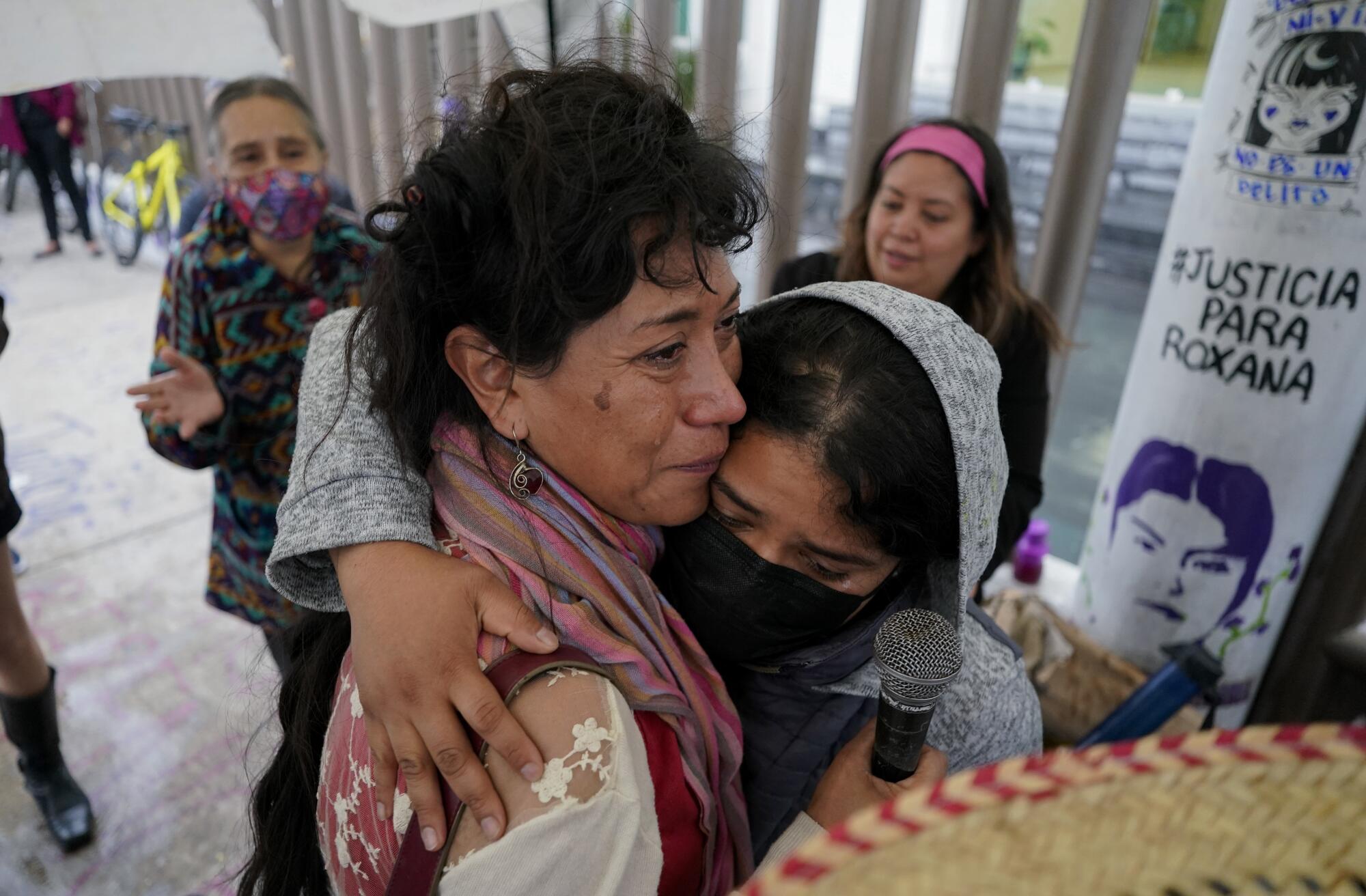
Narziso’s mother fought to harness that kind of outrage over her daughter’s case. She organized small marches with feminist groups, standing outside the Tijuana criminal courthouse with signs that declared “#FreeAlina” and “It was in self-defense!”
“I understood I had to make the case visible,” she said, “that it become viral.”
It did. About 57,000 people signed an online petition demanding Narziso’s release. Shortly after Narziso was convicted, Baja California’s governor said at a news conference that she supported the family.
In Mexico, women avoid the workplace for a day in a national strike
State congresswoman Liliana Michel Sánchez Allende, who spoke by phone with Narziso when she was in prison, said she realized Narziso had been cast as a criminal from the beginning by authorities who unfairly presumed she could have used less force.
“When you’re defending your life, protecting yourself and responding to aggression, you’re in a state of fear, a state of confusion, and it’s hard to respond proportionally to the violence that’s being inflicted on you,” Sánchez said.
The Baja congresswoman proposed a bill — similar to legislation passed in the spring in the state of Tlaxcala — that requires prosecutors to use a gender perspective when a woman is defending herself against violence.
The measure has been named “the Alina Law.”
In May, after Narziso had been in prison for more than three years, she returned to court in an orange prison jumpsuit to hear appellate judges rule on her case.
In a Mexicali courtroom, a three-judge panel found that Narziso had been abused by Juárez. And they excoriated the judge who sentenced her, saying he “simply discarded” testimony about the abuse.
The judges said that Narziso had behaved rationally by using Juárez’s gun, and that because he had continued to behave aggressively after she first shot him — demanding she kill herself — her last shots “were necessary.”
It was unreasonable, the judges said in a unanimous ruling, to expect she “had sufficient presence of mind to compare and measure the magnitude of the attack [and] to then measure the defense needed to protect her life.”
She was absolved. In the courtroom, Narziso, still wearing ankle cuffs, turned to her mother.
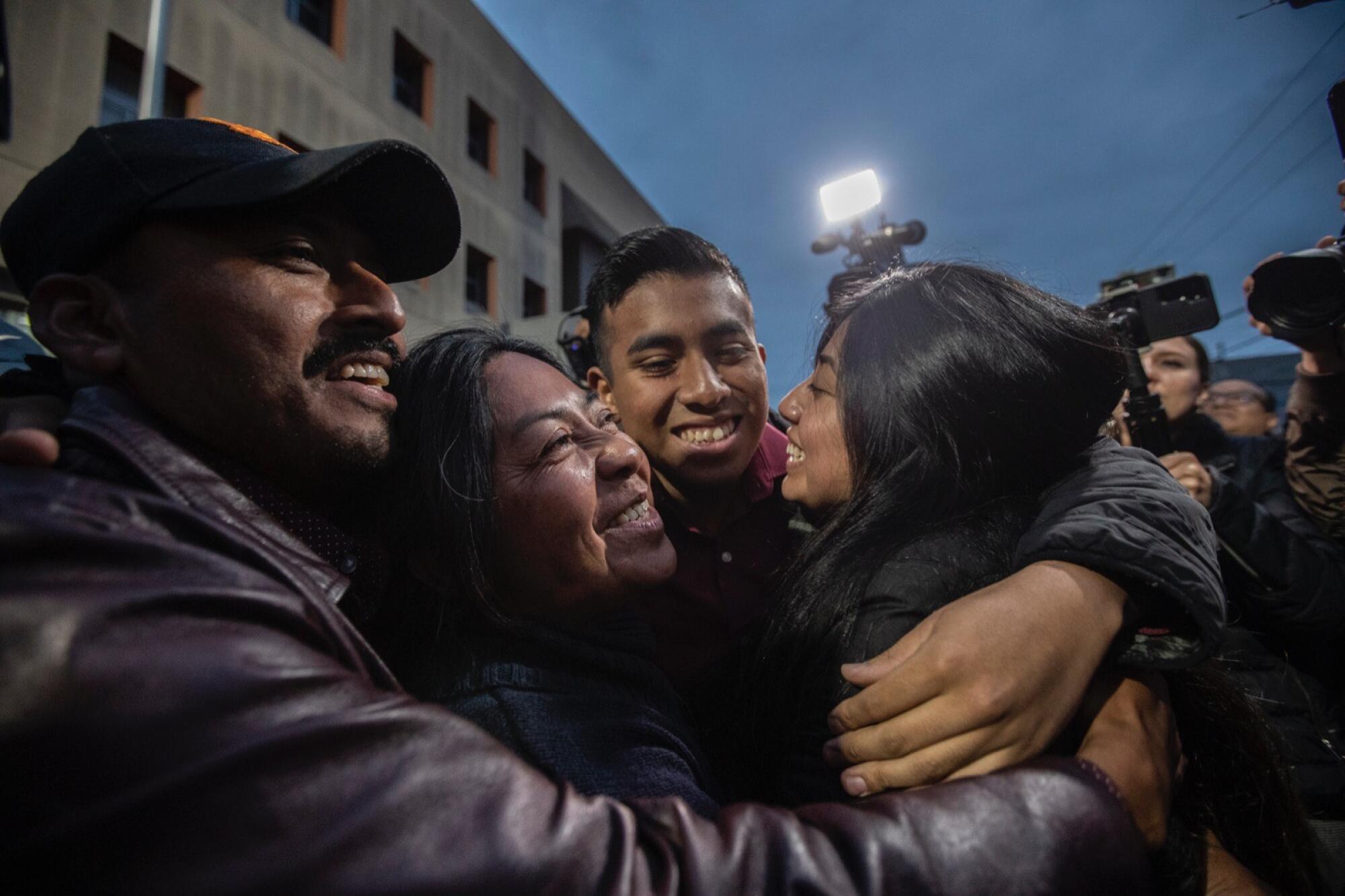
“I’m free, mom!” she said.
Rodrigo Juárez’s family members feel that justice has slipped away.
His mother, Teresa Arellanes, said in an interview that the case had been politicized to serve a feminist agenda.
“If I raise my voice, everyone will attack me,” she said. “Men today don’t have a voice or a vote, unfortunately.… If I say that someone hit me, they’re going to believe me for the simple fact that I’m a woman.”
Arellanes denied that her son was violent. She said that a few days before he died, Juárez had said he wanted to soon move back home, telling her that Narziso was a very jealous girlfriend.
“If he had been aggressive or if it was a couple’s fight, she could have shot him in the leg and gotten out,” Arellanes said. “She had the opportunity and didn’t give it to my son.”
Today, Narziso, her mother and her 20-year-old half brother live together in Tijuana. Narziso has decided to not return to the police and is considering getting a degree in psychology.
Some question whether Narziso’s case will truly change how officials view similar situations. The appellate court ordered a disciplinary process opened against the trial judge and required him to receive legal training on women’s rights.
But Baja California’s chief prosecutor has told reporters that although he respected the appellate court’s decision, he still backed the 60-year sentence that prosecutors had sought against Narziso.
“We defend the work the prosecutor’s office presented at the time,” he said.
In 2020, almost a year after Juárez’s death, Arellanes attended the ribbon-cutting inauguration of a small Tijuana park called the Plaza of the Police.
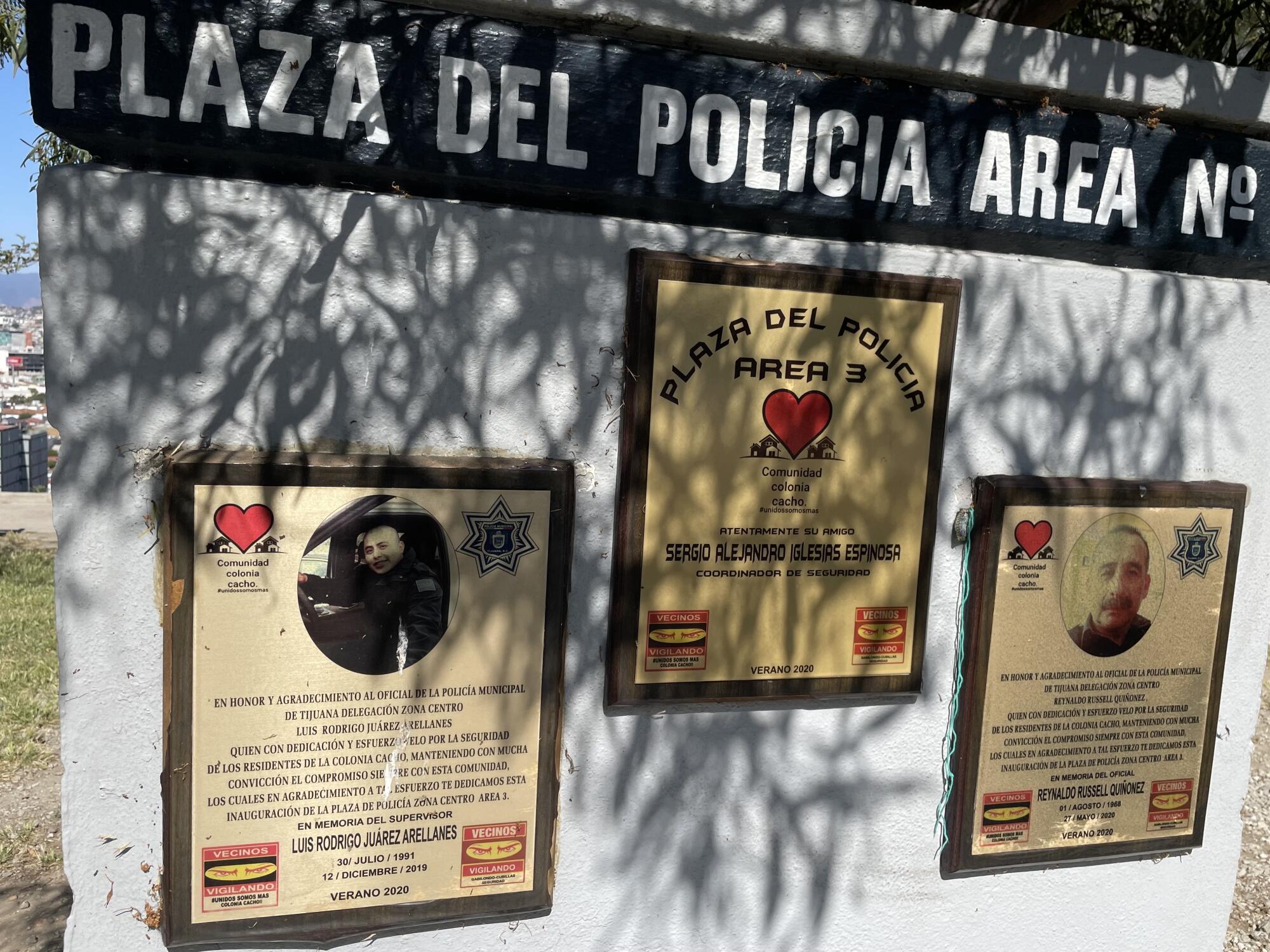
Near an exercise bicycle and strength training equipment, a concrete wall held plaques honoring an officer who died of a medical condition and Juárez. One plaque, which featured Juárez’s picture, praised him as someone “who with dedication and effort ensured the safety” of the residents in the neighborhood.
Last month, local feminist collectives ripped both plaques off the wall and scrawled “Plaza of terrorists” in purple spray paint, along with the message that women being abused shouldn’t have to choose between prison or death.
Narziso said she supported the message. “There shouldn’t only be those two options for people who experience violence.”
Special correspondent Cecilia Sánchez in The Times’ Mexico City bureau contributed to this report.
Watch L.A. Times Today at 7 p.m. on Spectrum News 1 on Channel 1 or live stream on the Spectrum News App. Palos Verdes Peninsula and Orange County viewers can watch on Cox Systems on channel 99.
More to Read
Sign up for Essential California
The most important California stories and recommendations in your inbox every morning.
You may occasionally receive promotional content from the Los Angeles Times.
